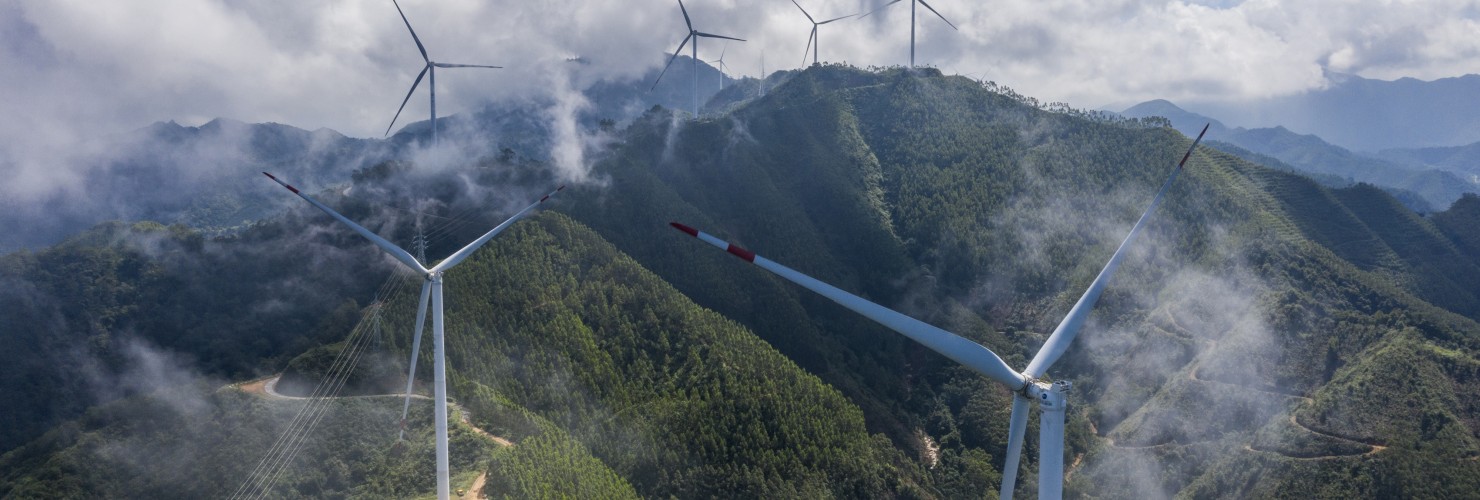

It’s time for climate competition with China
Brussels and Beijing are entering a new phase in their climate relations. Gone are the days when the EU and China were only climate partners. Now Brussels would be well-served to compete and spur China on when it comes to climate protection.
The European Union has long considered China a partner in mitigating climate change. After all, this is a global issue that requires all countries to curb their greenhouse gas emissions. As the world’s largest emitter, this holds particularly true for China. Cooperation has therefore been the defining prism of EU-China climate relations. During this time, there have been notable successes: Besides being a party to the Paris Climate Agreement, China has announced to no longer build and finance new coal-fired power plants abroad, it has issued an action plan to peak its carbon emissions by 2030 and pledged to reach carbon neutrality by 2060.
These new carbon milestones are leading EU-China climate relations into a new phase. Climate cooperation alone may have run its course. Climate competition should increasingly define the EU’s policy towards China. Two factors impel Brussels to embark on such an approach.
First, China remains a climate risk. It is no longer about getting Beijing to sign up to climate targets. It’s about getting Beijing to increase its ambition and implement the necessary measures. Not only is China the world’s largest emitter of greenhouse gases, but at present it is also an impediment to reaching the Paris climate target of preferably limiting global warming to 1.5 degrees Celsius. It helped water down the Glasgow Climate Pact, by weakening language on phasing-out coal power. And according to Climate Action Tracker its current climate targets and policies are incompatible with the 1.5-degree target. The 1.5-degree-compatible scenarios foresee rapid CO2 reductions over the next five to ten years. However, China’s pledge to peak emissions before 2030 is rather vague. Beijing must be asked: How long before 2030 will China reach its carbon peak? China’s Action Plan for Reaching Carbon Dioxide Peak Before 2030 sets undecipherable targets by using the Corona year 2020 as a baseline and tying CO2 reduction targets to GDP development. The document also states that national energy security and economic development must come first and that it is necessary to “win time.”
Beijing’s focus on carbon emissions and carbon neutrality also ignores other harmful emissions, such as methane and nitrous oxide. Both of which are respectively 25 and 300 times more potent than carbon dioxide. Even if all fossil fuel emissions were to be eliminated immediately, studies show that without significant emission reductions from agricultural systems, it is impossible to limit global warming to 1.5 degrees. As the world’s largest methane emitter, China has a particular responsibility here. Yet, Beijing did not sign up to the Global Methane Pledge, which over one hundred countries signed at COP26 in Glasgow. It is no surprise that methane emission reductions feature significantly in the U.S.-China Joint Glasgow Declaration and that the US pushed Beijing to increase its climate efforts in this critical decade.
China itself no longer seems particularly interested in climate partnership. Beijing has started to strategically link the issue of climate protection to other political areas, such as human rights. By arguing that climate cooperation is dependent on how the West engages with China in other areas, Beijing has shown a high degree of cynicism. It degrades climate cooperation to a means for different political ends. Apparently, there’s no inherent Chinese interest in climate cooperation. Brussels cannot cooperate with Beijing on such a basis of understanding.
Second, the EU should focus on competing with China in the field of climate protection because it is a climate economy competitor. The world economy is in the grips of two fundamental transformations: digitalisation and decarbonisation. With its goal of becoming a global economic centre by mid-century, the leadership in Beijing aims to be at the forefront of those twin developments. This means that China’s decarbonisation efforts particularly serve economic and political purposes: to gain economic and technological leadership, to foster dependencies and to promote international influence.
For Beijing, protecting the climate means dominating the green technologies. It has made great progress in this regard. China produces nearly three-quarters of the world's photovoltaic modules, controls more than a third of the global market for wind turbines and dominates the global production of electric car batteries. In addition, China is the biggest producer of key metals, such as crude steel and aluminium, as well as being the dominant global supplier for critical minerals such as rare earth elements, all necessary inputs for green products. These markets, which will continue to grow in importance as climate protection efforts intensify, are the drivers of future prosperity. Recent statements by Xi Jinping calling for a greening of China’s Belt and Road initiative (BRI), demonstrate that Beijing is intent on becoming the world’s ecological modernizer.
If Europe lets China take on this role, it will lose relevant markets – something already observed in the European solar industry. The European wind industry is at risk of undergoing a similar scenario. The proposed EU-China Comprehensive Agreement on Investments (CAI) could potentially exacerbate this situation. It would provide European market access to Chinese renewable energy companies, while European companies continue to struggle to enter the Chinese energy market, which is dominated by state-owned enterprises. Siemens Gamesa, for instance, has decided to exit the Chinese onshore wind market, arguing that in reality this is a “market for domestic producers”. The Chinese government is inhibiting foreign access to its renewable energy market, preferring instead to bolster Chinese renewable energy companies to become strong enough to compete internationally. The domestic market acts as a springboard for their entry into the global market. Beijing is taking a page from its digital sector playbook, where it closed its digital market to foreign companies in order to grow indigenous tech giants, which then – based on their advantage of a captured domestic market – expanded internationally.
China as a climate risk and climate economy competitor places the EU in a paradoxical situation: Brussels needs Beijing to join the 1.5-degree pathway by decarbonizing faster, while simultaneously making sure that China’s decarbonization drive does not come at Europe’s economic expense. It is imperative for the EU to stay ahead of China when it comes to green technology markets.
Under these circumstances, the EU’s climate strategy towards China should include three elements:
- driving forward Europe’s decarbonisation efforts and protecting its industry from Chinese anti-competitive behaviour,
- expanding Europe’s green leadership in the world by partnering with developing countries,
- pressuring China to raise its ambition via economic leverage.
In detail, Europe must drive forward its Green Deal agenda by investing in green tech such as hydrogen. It should promote green tech projects via the new EU guidelines on state aid for climate, environmental protection and energy, and advance support schemes such as Carbon Contracts for Difference to facilitate energy-intensive industries, such as cement and steel to decarbonize their production.
Simultaneously, it should push China to allow access to its markets while acting against anti-competitive behavior from China in the green tech space by using trade defence and equalizing instruments such as the International Procurement Instrument and anti-dumping measures. The EU’s recent imposition of tariffs on imports of Chinese steel towers used for wind turbines is one example. The EU should monitor the development of its renewable energy market and subsidiary markets in order to detect market distortions early on.
Second, the EU should compete with China’s Belt and Road Initiative by becoming the global south’s renewable industrializer. The Global Gateway Initiative is a great opportunity to promote climate-compatible infrastructure in the world. Based on the Just Energy Transition Partnership between South Africa, the EU and the US, the G7 – under Germany’s presidency – should advance climate partnerships between developing and industrialised countries.
This would not only expand Europe’s international climate leadership and open up opportunities for green markets, but it could also foster closer relations between the EU and developing countries when it comes to putting more pressure on China. As part of the G77, China has always portrayed itself as fighting for the interests of the global south. However, the fact that China’s climate announcements do not set any concrete emission reductions in this critical decade, goes against the interests of developing states. In this context, by partnering with developing countries on climate protection, the EU could increase pressure on China to do more or face international climate criticism.
Last but not least, the EU can compel China to raise its ambitions via setting its own high enivronmental standards in its market and economic leverage enacted through its planned Carbon Border Adjustment Mechanism (CBAM). This would alter Chinese companies’ economic calculus. Ideally, other countries in North America and Asia, such as the US and Japan, would join such an initiative.
Xi Jinping’s written statement at the COP26 was in essence an empty-worded call for business-as-usual. He emphasised the need to maintain consensus and called for concrete action without providing any more details on China’s pledge to peak carbon emissions before 2030.
The 2020s, however, are a critical decade for limiting climate change and for advancing competitive climate economies. While remaining open to climate cooperation, the EU should therefore promote the competition dimension. Climate competition with China holds the potential to bring more climate progress.
This article was first published by Heinrich Böll Foundation on January 17, 2022.

